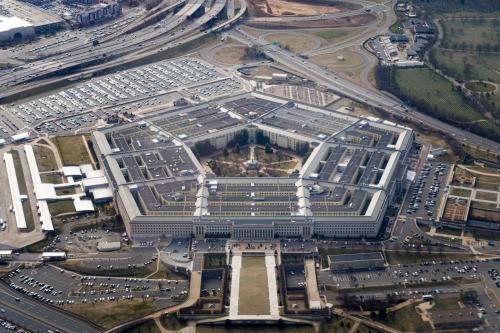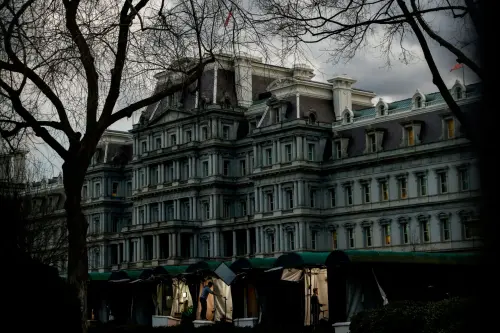It may come as a surprise to many Americans that the mission of the United States Department of Defense (DOD) is not “To fight and win the nation’s wars.” It is, instead, “to provide the military forces needed to deter war and ensure our nation’s security.” Although it is a sentence shorter than some coffee orders at Starbucks, this statement captures important ideas about what causes war, what prevents it, and therefore what the DOD needs to be able to do to protect the people and prosperity of the United States.
What does it mean to deter?
The idea of deterrence is the central feature of the DOD mission statement. Deterrence is a very common-sense proposition. It starts with the observation that costs and benefits affect how people make decisions about whether to behave in certain ways. In general, history leads us to believe that people take action when the benefits of doing so are higher than the costs and do not take action when that math is reversed. The implication is that raising the costs or lowering the benefits another actor can expect from a particular behavior will make them less likely to do it—that it will deter them.
This is a simple insight in theory, but it is difficult to do in practice. Attempts to deter always can, and often do, fail. To have a good chance at being effective, deterrence requires having some knowledge of what costs and benefits the other actor cares about. The likelihood of deterring effectively also depends upon the ability to communicate to the other actor that if they behave in a particular way then they will have to pay those costs, or that they will lose those benefits.
What does the DOD try to deter?
The deterrence job of the Department of Defense is to try to convince other actors, usually countries but also non-state actors like terrorist organizations, that they will suffer more than they will gain if they go to war with the United States or its treaty allies. It seeks to deter attacks with nuclear, chemical, and biological weapons, often called weapons of mass destruction, and attacks with conventional weapons like bullets, explosives, or fire-producing bombs and missiles. The U.S. military is often one element of larger government efforts to deter other kinds of unwanted behavior, usually actions policymakers believe threaten America’s most important, or vital, national interests or that violate international law. The United States Armed Forces have been involved, for example, in efforts to deter the harassment of ships operating legally at sea, to deter unauthorized tests of nuclear capabilities, and to deter governments from using violence against their own populations.
How does the DOD try to deter war?
The DOD’s priority mission is always to deter other countries from waging war against the United States. To achieve this, the DOD works to convince all potential adversaries that going to war with the United States will cost them far more than they stand to gain.
Since 1945, the Department of Defense has sought to deter war in three ways. The first is through the size and quality of conventional U.S. military forces—the equipment and operational skill of its all-volunteer Army, Navy, Marine Corps, and Air Force. The DOD determines the necessary size, composition, and locations of these forces based on its assessment of the types, sources, and likelihoods of potential threats to the territory and people of the United States. These assessments include consideration of the second means through which the United States seeks to deter war: its defense alliances with other countries.
U.S. defense alliances are treaty-based commitments that the United States enters into to confirm that it will come to the aid of another country if that country is attacked. In some alliances, that guarantee works in both directions. In others, the United States does not necessarily expect direct military assistance but instead asks the ally to cooperate on other policies that contribute to U.S. national security. In this way, U.S. defense alliances are intended to increase the opposing force a potential adversary must expect to face if it chooses to attack either a U.S. ally or the United States itself. The United States entered into the alliances it has today after learning from the experiences of World War I, World War II, and other conflicts that wars even in distant parts of the world harm the U.S. economy and can threaten the American way of life.
The conventional military capabilities and defense alliances the United States uses to try to deter war are accompanied—or, as it is sometimes said, are “backstopped” —by its arsenal of around 5,000 nuclear weapons.1 The United States makes clear in its policies that its nuclear weapons exist because they are necessary to deter any other actor’s use of a nuclear weapon on the territory of the United States or of its allies. During some periods of history, U.S. policymakers concluded that nuclear weapons also were necessary to deter conventional war. This was the case for some of the 50 years of the United States’ Cold War with the Soviet Union, which had very large conventional forces in positions that were directly threatening to America’s North Atlantic Treaty Organization (NATO) allies in Europe. After the end of the Cold War in 1991, the United States enjoyed such a clear, global, conventional military advantage that some policymakers believed nuclear threats were not necessary to deter conventional war. All possible adversaries, of course, were also still well aware of the U.S. nuclear arsenal.
Does the DOD have what it needs to try to deter war?
There is disagreement within the U.S. national security community about what conventional forces, defense alliances, and nuclear weapons are needed to try to deter war in what the DOD calls today’s era of great power competition with China and Russia. Some policymakers and analysts think that the most effective way to try to deter China and Russia, and also the smaller but still threatening countries of Iran and North Korea, is for the United States, together with its defense treaty allies, to have clear conventional military superiority. They argue that if the leaders of these states see that they cannot win a war against the United States, then they won’t start one.
This group recommends making substantial investments of taxpayer money in the DOD budget so that it can achieve superiority by buying conventional weapons and other modern warfighting systems. Some believe that nuclear superiority already is, or soon might become, equally necessary, and therefore also recommend increased spending on the infrastructure that maintains the current U.S. nuclear arsenal and that would be used to produce new weapons, if policymakers were to decide to do so. Many who take this view argue that the Biden administration’s request of $875 billion to fund both the Department of Defense and the Department of Energy’s (DOE) nuclear activities in fiscal year 2025 is inadequate to achieve lasting military superiority.
Others, however, do not think it is wise to try to achieve clear military superiority over China. They argue that if such a war were to happen, it would almost certainly be far away from the continental United States, in the seas of East Asia. The U.S. military would be challenged not only by China’s military, which is growing in size and sophistication, but also by distance and the difficulties of operating in an ocean environment. This group warns that attempting to achieve superiority would therefore be immensely expensive and still might not achieve the goal of persuading China that it would lose a war with the United States and its allies. Instead, these analysts recommend that the United States and its allies try to deter China by convincing it that a decision to go to war would be enormously militarily and economically costly and undermine the status, standing, and influence that China has with many countries in the world.
How have Trump and Biden tried to deter war?
During their terms in office, both President Donald Trump and President Joe Biden demonstrated that they think U.S. conventional and nuclear military capabilities are necessary to try to deter war. Both presidents requested annual increases in the DOD conventional and DOE nuclear budgets, which together grew from roughly $650 billion in 2018 to roughly $875 billion in 2024.
Trump and Biden, however, took sharply different approaches to U.S. defense alliances. The Biden administration emphasized that there is great value in the role U.S. defense alliances play in trying to deter war—that the money and effort the United States spends to have defense alliances is worth it. Biden worked to show that U.S. defense alliances are not only militarily strong but that they also will team together to use other tools of national power—like economic sanctions, defense equipment transfers, trade policies, and diplomatic actions in international institutions like the United Nations—to impose consequences if states choose to pursue their goals through war. This is what the United States, its NATO allies, and other partners have done to Russia since it invaded Ukraine in February 2022.
During his term as president, and now as a presidential candidate, Trump has expressed doubt about whether U.S. defense alliances make important contributions to deterring war or support U.S. national security. He believes that America’s allies have not invested enough in their own defense and instead are free-riding and taking advantage of the larger and more capable U.S. military. Trump has repeatedly suggested that because of this he might withdraw from more than one of America’s defense alliances or simply not honor their terms.
Breaking U.S. defense alliances would mean that the DOD’s mission would be to deter attacks only against the United States. This would change how and where the U.S. military operates. It is very likely that if the United States leaves its defense alliances, then many European countries, Japan, South Korea, and others will try to deter attacks on their territories by increasing their conventional militaries. They might also seek to get nuclear weapons if they don’t already have them and to increase their nuclear arsenals if they do. If U.S. defense alliances do influence how leaders in Russia, China, and elsewhere calculate what they stand to gain or lose through war, then the absence of U.S. defense alliances might also make these states more likely to try to achieve their goals through the use of force.
The decision that American presidents make about how to try to deter war is therefore a very serious one. It can affect how U.S. taxpayer dollars are spent, it can affect the size of other countries’ militaries, and it can affect the number of nuclear weapons in the world. Biden and Trump have very different views on how to try to deter wars that can harm the people and prosperity of the United States. These differences mean that America’s allies, and its potential adversaries, will be watching the outcome of November’s election with great interest.
-
Footnotes
- The total count includes deployed, reserve, and retired nuclear warheads.
The Brookings Institution is committed to quality, independence, and impact.
We are supported by a diverse array of funders. In line with our values and policies, each Brookings publication represents the sole views of its author(s).







Commentary
What is deterrence, and what is its role in U.S. national defense?
May 1, 2024